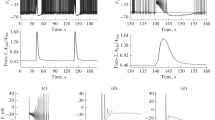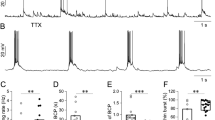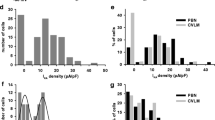Abstract
Intracellular and voltage-clamp studies were carried out to clarify the mechanism for spontaneous firing activity in neurons of the suprachiasmatic nucleus (SCN) of rat hypothalamic brain slices in vitro. SCN neurons displayed spontaneously firing action potentials that were preceded by a depolarizing pre-potential and followed by a short spike after-hyperpolarization (AHP). Injection of inward current with a duration longer than 50 ms resulted in a depolarizing voltage “sag” on hyperpolarizing electrotonic potentials. The inward rectification was depressed by bath application of caesium (1 mM) but not by barium (500 μM). SCN neurons also showed a rebound depolarization associated with spike discharge (anodal break) in response to relaxation of hyper polarizing current injection. The rebound depolarization was reduced by nominally zero calcium. Cadmium (500 μM), cobalt (1 mM) or caesium (1 mM) but not nicardipine also depressed the rebound depolarization. Under voltage-clamp conditions, hyperpolarizing steps to membrane potentials negative to approximately −60 mV caused an inward rectifier current, probably H current (I H), which showed no inactivation with time. Bath application of caesium (1–2 mM) suppressed I H. Caesium (2 mM) depressed the slope of the depolarizing spike pre-potential, resulting in a prolongation of the interspike interval of tonic firing neurons. We conclude that both the inward rectifier current, I H, and the low-threshold calcium current contribute to the spike prepotential of spontaneous action potentials in firing neurons of the rat SCN.
Similar content being viewed by others
References
Bos NPA, Mirmiran M (1990) Circadian rhythms in spontaneous neuronal discharges of the cultured suprachiasmatic nucleus. Brain Res 511: 158–162
Constanti A, Galvan M (1983) Fast inward-rectifying current accounts for anomalous rectification in olfactory cortex neurones. J Physiol (Lond) 335: 153–178
Friedman A, Gutnick MJ (1987) Low-threshold calcium electrogenesis in neocortical neurons. Neurosci Lett 81: 117–122
Green DJ, Gillette R (1982) Circadian rhythm of firing rate recorded from single cells in the rat suprachiasmatic brain slice. Brain Res 245: 198–200
Greene RW, Haas HL, McCarley RW (1986) A low threshold calcium spike mediates firing pattern alterations in pontine reticular neurons. Science 234: 738–740
Griffith WH (1988) Membrane properties of cell types within guinea pig basal forebrain nuclei in vitro. J Neurophysiol 59: 1590–1612
Groos G, Hendriks J (1982) Circadian rhythms in electrical discharge of rat suprachiasmatic neurones recorded in vitro. Neurosci Lett 34: 283–288
Ito C, Wakamori M, Akaike N (1991) Dual effect of glycine on isolated rat suprachiasmatic neurons. Am J Physiol 260: C213-C218
Jahnsen H, Llinás R (1984) Ionic basis for the electroresponsiveness and oscillatory properties of guinea-pig thalamic neurones in vitro. J Physiol (Lond) 349: 227–247
Kim YI, Dudek FE (1991) Intracellular electrophysiological study of suprachiasmatic nucleus neurons in rodents: excitatory synaptic mechanisms. J Physiol (Lond) 444: 269–287
Lehman MN, Silver R, Gladstone WR, Kahn RM, Gibson M, Bittman EL (1987) Circadian rhythmicity restored by neural transplant. Immunocytochemical characterization of the graft and its integration with the host brain. J Neurosci 7: 1626–1638
Llinás R, Yarom Y (1981) Electrophysiology of mammalian inferior olivary neurones in vitro. Different types of voltage-dependent ionic conductances. J Physiol (Lond) 315: 549–567
Mayer ML, Westbrook GL (1983) A voltage-clamp analysis of inward (anomalous) rectification in mouse spinal sensory ganglion neurones. J Physiol (Lond) 340: 19–45
McCormick DA, Connors BW, Lighthall JW, Prince DA (1985) Comparative electrophysiology of pyramidal and sparsely spiny stellate neurons of the neocortex. J Neurophysiol 54: 782–806
Meijer JH, Rietveld WJ (1989) Neurophysiology of the suprachiasmatic circadian pacemaker in rodents. Physiol Rev 69: 671–707
van den Pol AN (1980) The hypothalamic suprachiasmatic nucleus of rat: intrinsic anatomy. J Comp Neurol 191: 661–702
Ralph MR, Foster RG, Davis FC, Menaker M (1990) Transplanted suprachiasmatic nucleus determines circadian period. Science 247: 975–978
Rudy B (1988) Diversity and ubiquity of K channels. Neuroscience 25: 729–749
Rusak B, Zucker I (1979) Neural regulation of circadian rhythms. Physiol Rev 59: 449–526
Sawaki Y, Nihonmatsu I, Kawamura H (1984) Transplantation of the neonatal suprachiasmatic nuclei into rats with complete bilateral suprachiasmatic lesions. Neurosci Res 1: 67–72
Spain WJ, Schwindt PC, Crill WE (1987) Anomalous rectification in neurons from cat sensorimotor cortex in vitro. J Neurophysiol 57: 1555–1576
Storm JF (1989) An after-hyperpolarization of medium duration in rat hippocampal pyramidal cells. J Physiol (Lond) 409: 171–190
Sugimori M, Shibata S, Oomura Y (1986) Electrophysiological bases for rhythmic activity in the suprachiasmatic nucleus of the rat: an in vitro study. In: Oomura Y (ed) Emotions: Neuronal and Chemical Control. Japan Scientific Societies Press, Tokyo, pp 199–206
Sutor B, Zieglgänsberger W (1987) A low-voltage activated, transient calcium current is responsible for the time-dependent depolarizing inward rectification of rat neocortical neurons in vitro. Pflügers Arch 410: 102–111
Takahashi JS, Zatz M (1982) Regulation of circadian rhythmicity. Science 217: 1104–1111
Thomson AM, West DC (1990) Factors affecting slow regular firing in the suprachiasmatic nucleus in vitro. J Biol Rhythms 5: 59–75
Thomson AM, West DC, Vlachonikolis IG (1984) Regular firing patterns of suprachiasmatic neurons maintained in vitro. Neurosci Lett 52: 329–334
Tokimasa T, Akasu T (1990) Cyclic AMP regulates an inward rectifying sodium-potassium current in dissociated bull-frog sympathetic neurones. J Physiol (Lond) 420: 409–429
Turek FW (1985) Circadian neural rhythms in mammals. Annu Rev Physiol 47: 49–64
Williams JT, North RA, Tokimasa T (1988) Inward rectification of resting and opiate-activating potassium currents in rat locus coeruleus neurons. J Neurosci 8: 4299–4306
Yung WH, Häusser MA, Jack JJB (1991) Electrophysiology of dopaminergic and non-dopaminergic neurones of the guinea-pig substantia nigra pars compacta in vitro. J Physiol (Lond) 436: 643–667
Author information
Authors and Affiliations
Rights and permissions
About this article
Cite this article
Akasu, T., Shoji, S. & Hasuo, H. Inward rectifier and low-threshold calcium currents contribute to the spontaneous firing mechanism in neurons of the rat suprachiasmatic nucleus. Pflugers Arch. 425, 109–116 (1993). https://doi.org/10.1007/BF00374510
Received:
Revised:
Accepted:
Issue Date:
DOI: https://doi.org/10.1007/BF00374510




